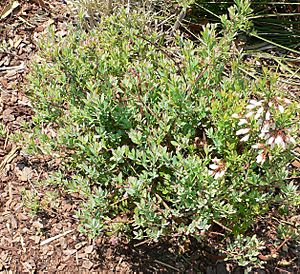Vaccinium darrowii facts for kids
Quick facts for kids Vaccinium darrowii |
|
|---|---|
 |
|
| Scientific classification | |
| Kingdom: | |
| (unranked): | |
| (unranked): | |
| (unranked): | |
| Order: | |
| Family: | |
| Genus: | |
| Species: |
V. darrowii
|
| Binomial name | |
| Vaccinium darrowii Camp 1942
|
|
| Synonyms | |
|
|
Darrow's blueberry, also known as the evergreen blueberry or scrub blueberry, is a type of blueberry. Its scientific name is Vaccinium darrowii. It belongs to the same plant family as other blueberries.
Contents
Where Darrow's Blueberry Grows
Darrow's blueberry naturally grows in the southeastern part of the United States. You can find it in states like Alabama, Florida, Georgia, Louisiana, and Mississippi.
This plant loves to live in pine forests. It grows best in sunny spots and in soil that is a little bit acidic.
What Darrow's Blueberry Looks Like
Darrow's blueberry is an evergreen shrub. This means its leaves stay green all year round. It usually grows about 30 to 120 centimeters (1 to 4 feet) tall.
Its leaves are small and shaped like an oval with a pointed tip. They are about 10 to 15 millimeters long. The leaves are light blue-green near the bottom of the plant. They can be light pink at the tips of the branches.
Flowers and Fruit
The flowers of Darrow's blueberry are white and shaped like bells. They are about 4 to 8 millimeters long.
The fruit is a small berry. It is about 4 to 6 millimeters wide. The berries are blue-black and have a whitish, waxy coating.
Growing Darrow's Blueberry
People grow Vaccinium darrowii for two main reasons. First, its berries are tasty and can be eaten. Second, it is a beautiful ornamental plant. People often plant it in their home gardens.
It is also used in native plant gardens. These gardens focus on plants that naturally grow in an area. It is also good for wildlife gardens and natural landscaping projects.
Hybrid Blueberry Plants
Many of the blueberries you see in stores are not just one type of blueberry. They are often hybrids. A hybrid plant is created by crossing two different types of plants.
Many commercial Southern Highbush Blueberry plants are hybrids. They are made by crossing Vaccinium darrowii with the Northern Highbush Blueberry (Vaccinium corymbosum). Other types of blueberries, like the Rabbiteye blueberry and Lowbush blueberry, are also used.
These hybrid blueberries are special. They do not need as much cold weather to grow well. They can also handle hot summer temperatures better. They are also a bit more resistant to dry weather. These hybrids grow very good fruit in the southern United States.
Southern highbush blueberries can usually pollinate themselves. However, if you plant several different types together, you might get bigger and earlier-ripening berries. This happens because of cross-pollination.
Here are some popular Southern Highbush Blueberry types:
- Very early season: 'O’Neal'
- Early/midseason: 'Cape Fear'
- Midseason: 'Blue Ridge' and 'Georgia Gem'
- Mid/late season: 'Legacy' and 'Summit'
- Late season: 'Ozarkblue'

